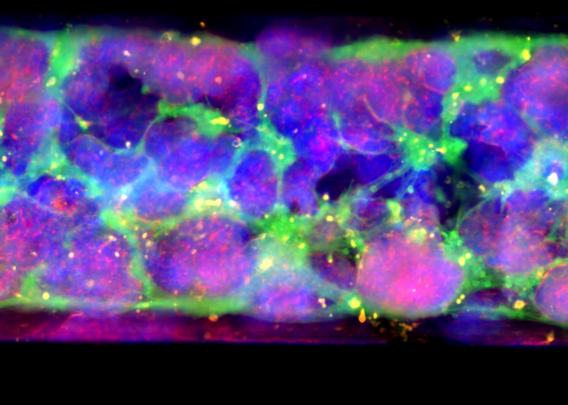As the demand for more human-relevant, ethical, sustainable and cost-effective safety and efficacy testing grows, New Approach Methodologies (NAMs) are rapidly becoming the new cornerstone of modern toxicology in drug discovery and development. NAMs represent a shift away from traditional animal models toward more predictive, mechanistically-informed systems that can assess human health risks with greater accuracy. But what exactly are NAMs, how do they work, and why are they capturing the attention of researchers, regulators, and industry leaders worldwide?
Let’s begin by defining what we mean by the term “NAM”. NAM has taken on several different meanings within today’s discourse on alternatives to animal models. While the terms is sometimes used to mean non-animal methods or new alternative methods, for the purposes of this blog, we will use NAMs to mean New Approach Methodologies.
“New Approach Methodologies” was formally coined in 2016 to encompass a broad range of techniques, technologies, and approaches that embrace ethical research principles and are increasingly being adopted for regulatory decision-making by agencies worldwide. In other words, for a new test or assessment method to be considered a NAM, it must be relevant for the regulatory hazard or safety assessment of a chemical, drug, or other substance.
This definition underscores an important point: NAMs aren’t just any new scientific method. They are fit-for-purpose tools that help evaluate safety in a way that regulators can use, moving us toward more predictive, human-relevant, and non-animal approaches.
In this blog post, we’ll explore the landscape of NAMs, break down the different types, explain how they can be used synergistically, and highlight the key factors driving their recent momentum.
What Are New Approach Methodologies (NAMs)?
New Approach Methodologies (NAMs) are a diverse suite of tools and technologies that can be used either alone or in combination with other methods to evaluate chemical and drug safety without relying on animal testing. The term encompasses in vitro, in silico, and in chemico methods, as well as frameworks for integrating data from multiple sources (e.g., Integrated Approaches to Testing and Assessment, or IATA).
NAMs are not a single test or platform. Rather, they include:
- Cell-based assays
- Organ-on-a-Chip systems
- Computational modeling (QSAR, PBPK, AI/ML)
- Omics technologies (transcriptomics, proteomics, metabolomics)
- Adverse Outcome Pathways (AOPs)
By focusing on human-relevant biology, NAMs aim to provide more accurate predictions of human health outcomes, reduce costs, and shorten development timelines—while also minimizing the ethical and scientific limitations of animal models.
Types of NAMs and What They Do
Let’s take a closer look at the most prominent categories of NAMs:
1. In Vitro Models
These models use cultured cells or tissues to assess biological responses to compounds and pharmaceuticals, including chemical and biological entities. Common systems include:
- 2D cell cultures: Widely used for basic toxicity screening.
- 3D spheroids and organoids: Offer more physiologically relevant structure and function.
- Organ-on-a-Chip models: Microengineered systems that mimic organ-level functions, enabling dynamic studies of toxicity, pharmacokinetics, and mechanisms of action.
Organ-on-a-Chip platforms in particular are gaining attention due to their ability to replicate complex tissue-tissue interfaces, fluid flow, and mechanical forces, offering a powerful bridge between cell culture and whole-organism physiology.
2. In Silico Models
Computational approaches simulate biological responses or predict chemical properties based on existing data. They include:
- Quantitative Structure-Activity Relationships (QSARs): Predict a chemical’s activity based on its structure.
- Physiologically Based Pharmacokinetic (PBPK) models: Model how chemicals are absorbed, distributed, metabolized, and excreted in the body.
- Machine Learning/AI: Leverage big data to uncover novel patterns and make toxicity predictions across the pharmaceutical space.
These tools can screen thousands of compounds in silico before any lab testing is done, helping prioritize candidates and reduce unnecessary experimentation.
3. Omics-Based Approaches
Omics technologies analyze large datasets from genomics, proteomics, metabolomics, and transcriptomics to identify molecular signatures of toxicity or disease. They offer:
- Mechanistic insights into how chemicals affect biological systems.
- Biomarker discovery for early indicators of adverse effects.
- Pathway-based analyses aligned with Adverse Outcome Pathways (AOPs).
These methods support a shift toward mechanistic toxicology, focusing on early molecular events rather than late-stage pathology.
4. In Chemico Methods
These techniques assess chemical reactivity without involving biological systems. A common application is testing for skin sensitization, where the ability of a compound to bind to proteins is evaluated directly through assays like the Direct Peptide Reactivity Assay (DPRA).
How NAMs Work Together: The Power of Integrated Approaches
One of the strengths of NAMs lies in their ability to complement each other. By combining in vitro, in silico, and omics data within integrated testing strategies (ITS) or frameworks like Integrated Approaches to Testing and Assessment (IATA), researchers can build a weight-of-evidence to support safety decisions.
For example:
- A computational model might predict that a compound is likely hepatotoxic.
- An Organ-on-a-Chip liver model can then test the compound’s effects on human liver tissue under physiologically relevant conditions.
- Transcriptomic profiling can reveal specific pathways perturbed by the exposure to the compound of interest.
- All this information can be fed into an AOP framework to map out the progression from molecular interaction to adverse outcome.
This synergy not only improves confidence in NAM-derived data but also aligns with regulatory goals to reduce reliance on animal testing while ensuring human safety.
Why Are NAMs Gaining Momentum Now?
Several converging trends are driving the growing interest in NAMs:
1. Scientific Advances
Technological innovations have made it possible to model human biology with unprecedented fidelity. From microfluidic Organ-Chips that more faithfully model human biology to AI-driven toxicity predictions, today’s NAMs offer tools that simply didn’t exist a decade ago.
2. Regulatory Support
Regulatory bodies around the world are actively encouraging the development and acceptance of NAMs. For example:
- US regulatory agencies have shown an unprecedented level of alignment and support for the NAMs in recent months. Both the Food and Drug Administration (FDA) and National Institutes of Health (NIH) have committed to phasing out animal testing and incentivizing the use of NAMs across academia and preclinical drug development. Just as recently as July 7th, the NIH announced that they would no longer fund animal-exclusive studies, instead requiring all new proposals to include considerations for NAMs.
- The UK government has released their Life Sciences Sector Plan, which outlines their goal of driving the development alternatives to animal models through an infrastructure of translational networks and hubs.
- European agencies like the European Food Safety Authority (EFSA) and the European Chemicals Agency (ECHA) are incorporating NAMs into risk assessment frameworks.
- The Organisation for Economic Co-operation and Development (OECD)—a global entity that comprises 38 member countries—has published guidelines for validated NAMs such as the DPRA, KeratinoSens™, and human Cell Line Activation Test (h-CLAT).
Regulators are working collaboratively and increasingly globally to harmonize acceptance criteria and promote the use of NAMs for pharmaceutical and chemical safety evaluation.
3. Ethical and Social Pressure
Public concern over animal testing continues to grow, especially in cosmetics, food, and consumer products. NAMs offer a scientifically robust and ethically preferable alternative, aligning with principles of the 3Rs: Replacement, Reduction, and Refinement.
4. Economic and Efficiency Gains
NAMs can significantly reduce development costs and timeframes. High-throughput screening and predictive modeling allow companies to quickly eliminate unviable candidates early in development, saving millions in downstream costs.
Conclusion: NAMs Are Here to Stay
New Approach Methodologies are more than a replacement for animal testing—they represent a transformation in how we can better understand and assess the safety and efficacy of compounds and biologics. By integrating in vitro models, computational tools, and omics-based insights, NAMs offer a pathway to faster, more predictive, and human-relevant science.
As regulatory frameworks evolve and validation efforts expand, NAMs will play an increasingly central role in toxicology, risk assessment, and drug development. For industry leaders, researchers, and regulators alike, the time to invest in and adopt NAMs is now.




